- Italy Tours Home
- Italy Ethos
- Tours 2023
- Blog
- Contact Us
- Dolomites
- Top 10 Dolomites
- Veneto
- Dolomites Geology
- Dolomiti Bellunesi
- Cortina
- Cadore
- Belluno
- Cansiglio
- Carso
- Carnia
- Sauris
- Friuli
- Trentino
- Ethnographic Museums
- Monte Baldo
- South Tyrol
- Alta Pusteria
- Dobbiaco
- Emilia-Romagna
- Aosta Valley
- Cinque Terre
- Portofino
- Northern Apennines
- Southern Apennines
- Italian Botanical Gardens
- Padua Botanical Garden
- Orchids of Italy
Pieve di Cadore: Art and Nature in “Titian’s Dolomites”.
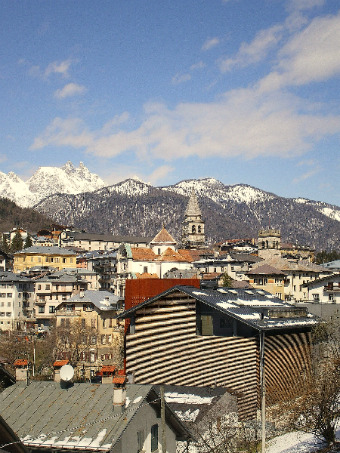
Pieve di Cadore has always been – and still is today – the
main administrative centre of the region. The term ‘Pieve’ refers to the
church, and it clearly implies that this was the “mother church” of Cadore in the old times, exercising a certain degree of control and coordination over all the
others.
For an historical outline on the region, I would redirect you to the page dedicated to the general information on Cadore, while the goal of this page is to concentrate more on what you can find in Pieve itself and in its immediate vicinities. I’d like to start from what you can visit in the centre of Pieve di Cadore.
Pieve, the Small Capital of Cadore
First and foremost, you will notice that this doesn’t look very much like a “mountain village”, but actually rather more like a small town in its own right – and that’s hardly a surprise, when you consider its history: this has been for centuries the ‘representative’ face of Cadore – the “little capital” of an historically almost semi-independent region.
Pieve di Cadore is situated right in the middle of Cadore, in an easily reachable position from which one can radiate in all directions, and being the ‘centre’ – thus entertaining a relationship with the capital (which, for about 350 years, was Venice) – it had to have a certain status.
This strong connection with the Republic of Venice is reflected in the urban quality of the built environment, which owes a lot to the Venetian style. Pieve di Cadore also acted like a hub from which new ideas arrived from the capital, and would spread afterwards into even the remotest corners of the region.
Being the ‘centre’, and easily reachable, however, once meant also being exposed – and this very fact stands at the origins of the settlement (incidentally, it is also what gave the region its name), as Cadore derives from Catubrigum, which roughly means the castle on the hill.
The reason for that name is simple: above Pieve di Cadore is a natural hill, Monte Ricco, gently sloping on the side of town, but steep and unapproachable on the other – and its very nature made it the obvious location on which to erect a fortification.
The castle of Pieve di Cadore had a tormented history, many centuries long, and its inglorious end was caused by the Napoleonic troops, finally dismantling the fortress in the early 1800s (just after the fall of Venice).
That wasn’t the complete end of the story, though, as on the sediment of the castle was later erected a twin fort that was used during World War I (“Forte Batteria Monte Ricco” and “Monte Castello”). After that, the structures fell into a long period of disrepair and abandonment, and it is only recently that work is finally underway to find a suitable purpose for these ruined buildings.
This is such a prime location for the history of the region that it would only make sense if a museum of local history took its seat here – but that is wishful thinking on my part, as to this day it is still unclear what the destination of the newly (and very slowly) restored structures will be.
Monte Ricco and the Roccolo Park
It is still a pleasure, though, to walk on the paths around Monte Ricco: the part of the hill closest to town is actually a public park (called Roccolo), and at the end of the main path you will be rewarded with an astonishing view over the lake of Centro Cadore, the artificial basin which was created by blocking the course of the river Piave in the late 1940s, as part of an extensive project aimed at energy production (this is the same context within which the infamous Vajont tragedy happened; below, an image of the lake from the Roccolo viewpoint).
The Castle of Pieve di Cadore
It is very interesting to read what is being written by G. Fabiani in his “Short History of Cadore”, in relation to the castle that was found here. «Dr. Jacobi and Mons. Ciani say that once Cadore had many fortresses and castles. We believe, however, that it only ever had two, even though the name ‘Castello’ (castle) is still given to many localities. The main castle of Cadore has always been the one in Pieve; nobody knows in what epoch it had been erected (the oldest citation for the Castello di Pieve is the one given by Martin Sanudo in his ‘itinerary’ of 1483); Dr. Jacobi maintains that it already existed in the year 900, when an invasion of Hungars took place. Rebuilt in 1656 because of a fire that had destroyed it for the greatest part, it was nonetheless solidly built: towards the river Piave it was inaccessible because of a steep precipice, while on the other side thick walls (‘mura a scarpa’) made it quite strong, until the invention of artillery, as this – both from Montericco and the elevations around Pieve – could easily beat it. The entrance was towards the west, and it was overseen by a tower; on the tower’s wall was a St. Mark’s lion, and inside, the prisons. In the interior was a round walk with the chancellor’s office and the captain’s house, a well, the barrack for the soldiers (garrison), a cistern, the storehouse for the weaponry and the ammunitions, the plant nursery, an oven and the little church of Santa Caterina. In the middle was a wide square, ruined in 1511 and restored between 1547 and 1565, and renewed again – as stated before – in 1656. With the decadence of the Republic of Venice starts also the decay of the castle buildings, which were not lived in consistently any longer. The captain – being his house inhabitable – was now obliged to live in the centre of Pieve. Despite not being cared for repair, the castle was nevertheless still guarded by a few soldiers; when the French came in 1797 it was still endowed with weapons and cannons; then, bit by bit, everything was taken away. In order to enlarge the main church in Pieve more stones were pillaged from the castle. The works that were carried out in the years following 1882 by the Italian military authorities in order to build the new fortifications destroyed what was left».
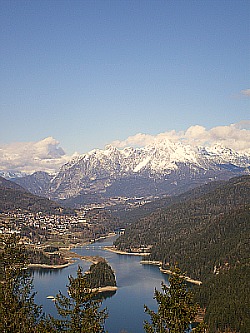
It was a time in which it was thought that artificial lakes such as this would enhance the “natural beauty” of the area, and improve its possibilities for tourism. Today, with conservation issues at the forefront, we see things differently, but this point of view has to be acknowledged as part of the development of ideas around landscape management, and within the context of the history of the land where we are.
So, after meandering for a while (you can’t get lost, as the Roccolo park is in fact like a huge mound isolated on all sides, so paths tend to be circular), get to the top, and enjoy the views from the small twin peaks of Monte Ricco and Monte Castello – just beware of the sheer precipice on one side of the summit!
Pieve di Cadore: Hometown to the Great Renaissance Master Titian
It is now time for us to go back into town. All the most notable buildings of Pieve di Cadore (bar one exception) are clustered around the central Piazza Tiziano (Titian Square).
And the name says it all – as Pieve di Cadore is the birthplace of the famous painter, Titian, more often than not associated with Venice (where he spent most of his adult life) than with this small Alpine town, where in fact he was born and bred.
But to be fair, Titian – who came from a respected family of artists – owed a lot to his native homeland, and never forgot his origins, and as you look at the background of some of his most celebrated paintings, you will recognize the familiar outline of the craggy mountains that he used to see as a child, and that you can still see all around Pieve di Cadore now (most notably the Marmarole – Dear to the Titian – and the Antelao, King of the Dolomites).
Unfortunately, though, not much remains here of Titian’s production in terms of paintings – in fact, only one work: the Madonna and Child with Saints in the main church, just off Titian Square.
It is a delightful painting – a mature work of art in which the Maestro depicts himself and members of his family as models. But however captivating this painting may be, there is also a sad story to tell, at least as a note of interest: the church that stood here prior to the current one – and which was demolished in the late 1700s – had a whole cycle of frescoes painted by the Great Master.
It was his most important cycle until then, as he tended to produce mostly individual oil paintings, but unfortunately that church was considered not big enough for the growing community, and also deemed structurally unstable, so it was ruthlessly demolished to build a “bigger and more beautiful one” – as a consequence, all the frescos were lost. An act like this sounds like sacrilege to us today, but it wasn’t considered such then, when priorities were clearly different.
However, several other works of art from the Vecellio (Titian’s surname) family are to be admired in the main church, which displays also a Fluegelaltar from the German painter Hans Klocher on the main altar.
The “Magnifica Comunità di Cadore” and Titian’s House
Back to the main square now, you may wonder what the massive turreted building that stands right in the middle of it is. It is not the town hall, as you might expect, but the headquarters of the “Magnifica Comunità di Cadore” – which literally translates as “Magnificent Community of Cadore”: an institution still very firmly in charge of preserving the cultural roots – and looking after the historical heritage – of this small but proud community (in the picture, a view of the Church from Piazza Tiziano, and the front of the Palazzo della Magnifica Comunità di Cadore).
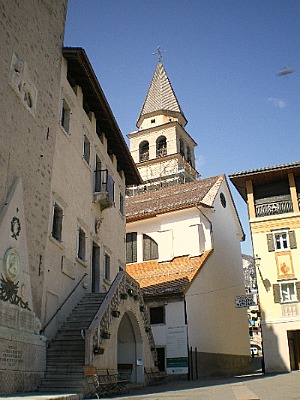
On the first floor of the building you may be able to peep through the grand salon (notice the massive painted beams), which hosts further paintings from the Vecellio family. Many cultural activities still take place here, while on the second floor is the Archeological Museum, displaying findings from the important site at Lagole (see Centro Cadore for more information).
In the basement, the vast vaulted room where horses would once be kept now hosts the “Gran Caffé Tiziano” – an historical coffee house and almost an institution in Pieve di Cadore: a traditional, animated meeting place, where it is particularly pleasant to spend time at the outdoor tables in the summer months, and watch the crowds go by.
Just a few metres off Titian Square, in a tiny square revived by an old gurgling fountain, is the humble dwelling reputed to be Titian’s birthplace, locally known simply as Casa di Tiziano (literally, Titian’s House).
It is a traditional Cadore vernacular house dating originally to the 15th century, and even though it was much restored in the early 1900s for presentation purposes, it is still well worth visiting nonetheless.
Built in stone, on the exterior is then super-imposed a wooden cladding that forms the traditional Cadore two-storey open balcony. But the most evocative part of the house is certainly the interior, and nearly all rooms have walls covered with the typical wooden boards made of ‘cirmolo’ – an aromatic wood obtained from the Arolla (or Swiss) pine (Pinus cembra).
The use of this material, by itself, makes a statement about the original owners of the house: not rich, but of a certain standing (as previously said, Titian came from the Vecelli or Vecellio, a well-known and respected family of artists; in the picture below, a sight of Titian’s House).
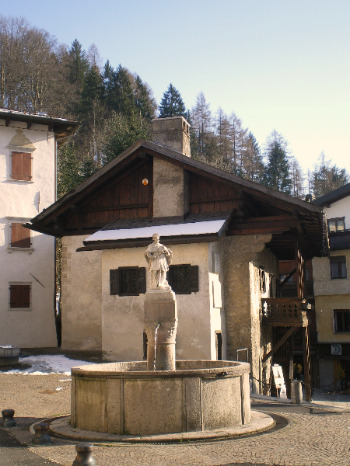
Nearby, the Casa Vallenzasca is said to contain a fresco traditionally attributed to the Titian (but there is no formal evidence), while back in Titian's Square, at the far back of it, is another building with a connection to the Vecellio family: the Casa di Tiziano l’Oratore (House of Titian the Preacher) – thus nicknamed to distinguish this Titian from the painter, as different members of the family often had the same name. This is now the headquarters of a Foundation on Titian's Studies which also hosts, at times, temporary exhibitions.
Out In Nature Around Pieve di Cadore
Around Pieve di Cadore there ample possibilities for walks and hikes of varying degrees of difficulty. The Rifugio Prapiccolo (now closed) is easily reached from Pozzale (an hamlet rich in old traditional Centro Cadore wooden houses, 2 km to the north), while the ascent to Monte Tranego (along an old military road, always starting from Pozzale), at nearly 2,000 metres, will reward you with sweeping views over the whole Centro Cadore area (below, an image of the old vernacular houses in the centre of Pozzale).
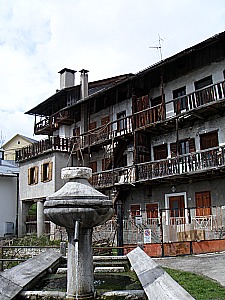
From both locations, it is possible to continue on more demanding trails which will take you into a wilder area, on proper Dolomite terrain dominated by the towering peaks of the Marmarole (2,932 m) and Antelao (3,263 m), with the possibility to connect on to further paths forming a circular route ending either in San Vito di Cadore in the Boite valley or in the Ansiei valley, north of Auronzo di Cadore.
Pieve di Cadore is also the crossing point of two Alpine Highways, the Alta Via No. 4, dedicated to Paul Grohmann (the famous Austrian mountaineer, first-time conqueror of so many peaks of the Dolomites), and the Alta Via No. 5, del Tiziano, also dedicated to the Great Master painter, who made the name of his homeland – Cadore – known to the world, and was said to dip his brushes into the rainbow.
But these are only suggestions for long hikes which would take several days to cover, with intermediate stops at a Rifugio (mountain hut) – and so they should not be undertaken lightheartedly, nor by the inexperienced walker.
If you fall into this category, there would be plenty of opportunities for you too; the “Grande Traversata del Cadore” (Great Traverse of Cadore), for instance, is an easy long-distance path that connects several villages and always keeps at a low altitude.
The aim of this trail is to show the interaction between human activities and the natural environment: this can be a great way of getting to experience both worlds – and acknowledge oneself with the cultural aspects of the region at the same time.
Part of the ‘Traversata’ runs on the actual slopes of Monte Ricco, while the section that will take you further into the heart of the region starts from Pozzale, and will then lead you from there towards Calalzo through the woods.
If you want to have more information regarding easy hikes and walks from Pieve di Cadore, I advise you to check also the page on Dolomite Sports.
In any case, Pieve di Cadore is the ideal base from which to start exploring the region of Cadore – whether you’ve come here to walk, see pretty villages or enjoy a combination of both, which is actually the best way to acquaint oneself with this most interesting Alpine area.
Lastly, if you love sports, do also have a look at the page dedicated to the Dolomite Sports, which focuses specifically on this area of Cadore and gives some more information on Pieve di Cadore too, from the viewpoint of a more active holiday.
Return from Pieve di Cadore to Cadore
Return from Pieve di Cadore to Italy-Tours-in-Nature
Copyright © 2012 Italy-Tours-in-Nature

New! Comments
Have your say about what you just read! Leave me a comment in the box below.